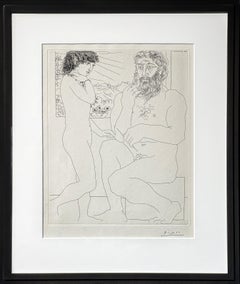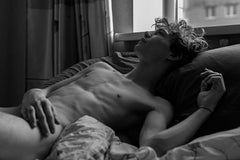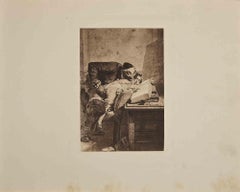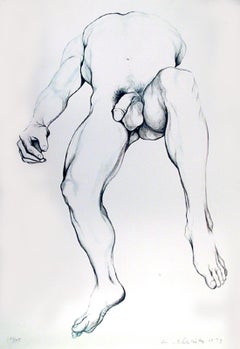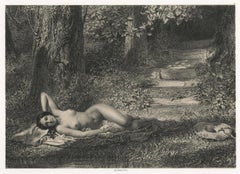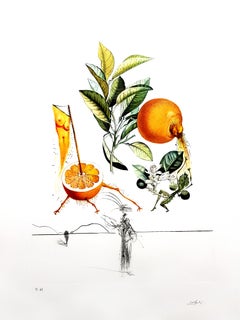Nude Prints
to
483
1,061
484
629
217
148
Overall Width
to
Overall Height
to
698
677
244
191
85
67
50
20
19
11
9
6
5
1
93
62
56
56
41
22
57
1,903
578
25
82
119
128
53
138
211
489
252
104
17
1,629
838
63
1,897
1,179
877
748
476
430
410
388
269
90
76
71
67
56
48
47
45
44
36
36
942
709
452
187
150
281
737
1,294
1,074
Nude Prints For Sale
Figurative Picasso Etching, 'Sculpteur et Modèle Debout', 1933
Located in New York, NY
Pablo Picasso's "Sculpteur et modèle debout" (1933), (which translates to "Sculptor and Model Standing") is a striking example of his exploration of the human form and his innovative...
Category
1930s Surrealist Nude Prints
Materials
Paper, Etching
Artem (5071) - In Celebration of Pride Month
Located in New Orleans, LA
Stone and Press Gallery is excited to offer several works in celebration of the LGBTQ community.
This impression is printed on Hahnemuhle archival paper. Hahnemühle FineArt, Inc. ...
Category
2010s Photorealist Nude Prints
Materials
Photographic Paper, Digital
$320 Sale Price
20% Off
Erotic Scene - Héliogravure by Micheal Von Zichy - 1911
Located in Roma, IT
Erotic scene is an original Héliogravure artwork on ivory-colored paper, realized by Micheal Von Zichy in 1911. Printed in only 300 copies, Leipzig; ...
Category
1910s Modern Nude Prints
Materials
Paper, Engraving
$662 Sale Price
30% Off
Male Nude 6, Photorealist Lithograph by Lowell Blair Nesbitt
Located in Long Island City, NY
This provocative portrayal of a male nude figure by Lowell Blair Nesbitt is very different from many of his other works featuring floral decoration and close-up depictions of flowers...
Category
1970s Photorealist Nude Prints
Materials
Lithograph
La Sortie du Bain
Located in Fairlawn, OH
Eugene Leroux (1807-1863)
La Sortie Du Bain
Lithograph, c. 1840
Signed in the lower left corner of the image (see photo)
Inscribed "Imp Bertauts Paris" in bottom margin
Inscribed "55...
Category
1840s Romantic Nude Prints
Materials
Lithograph
Salvador Dali - Erotic Grapefruit - Original Hand-Signed Lithograph
Located in Collonge Bellerive, Geneve, CH
Salvador Dali - Erotic Grapefruit - Original Hand-Signed Lithograph
1969
Dimensions: P. 57 x 37 cm
Sheet: 75 x 56 cm
Handsigned, EA (Epreuve d'Artiste)
Excellent Condition
Reference...
Category
1960s Surrealist Nude Prints
Materials
Lithograph
Femme Endormie, Cubist Lithograph after Pablo Picasso
Located in Long Island City, NY
This Pablo Picasso print portrays a nude woman who has fallen asleep. The figure reclines backward toward the viewer, resting on her back. The artist's use of flowing line and the br...
Category
1980s Cubist Nude Prints
Materials
Lithograph
Return, O Shulamite
Located in London, GB
Original Etching from the series ‘The Song of the Songs of King Solomon’ in colours with stencil on Arches wove paper.
signed and numbered by the artist
Paper size: 57.1 x 38 cm
Edi...
Category
1970s Surrealist Nude Prints
Materials
Etching
Etude pour le Nu, Cubist Lithograph after Pablo Picasso
Located in Long Island City, NY
Raising his hands behind his head, the nude figure in this Pablo Picasso print looks downward. Rendered in a neutral orange hue, the figure is shown fragmented in a series of simple ...
Category
Late 20th Century Cubist Nude Prints
Materials
Lithograph
Three Nudes - Original Lithograph (Morance, 1938)
By Le Corbusier
Located in Paris, IDF
Le Corbusier (1887-1965)
Three Nudes, 1938
Original lithograph
Signature printed in the plate
Dated in the plate
On light vellum 21 x 27 cm (c. 8 x 11 inch)
Very good condition, pa...
Category
1930s Modern Nude Prints
Materials
Lithograph
A model. Limited edition print Surreal Established Polish artist
Located in Warsaw, PL
Contemporary colorful figurative surrealistic print on paper by Polish artist Rafal Olbinski. This print shows a woman on sky background, crossing her arms and covering her chest. Th...
Category
2010s Surrealist Nude Prints
Materials
Paper, Color
$472 Sale Price
20% Off
Untitled from Doctors of the World Portfolio, hand signed & numbered Pop realism
By Chuck Close
Located in New York, NY
Chuck Close
Untitled Daguerreotypes, 2001
Two (2) pigmented digital output iris prints from daguerroeotype printed in a single sheet of wove paper
22 × 29 1/4 inches
Signed in pencil...
Category
Early 2000s Pop Art Nude Prints
Materials
Lithograph, Pigment, Pencil
"Party Girl" Contemporary limited edition etching
By Ian Laurie
Located in Brecon, Powys
Signed Limited Edition Etching from Artists Studio. 12 of 25
Image 11" x 7" Matted 16" x 12"
Ian Laurie was born in 1933 and is a self taught artist who made the transition from i...
Category
Early 2000s Modern Nude Prints
Materials
Etching
$200 Sale Price
20% Off
Leonor Fini, original lithograph from Satiricon, 1970
By Leonor Fini
Located in Saint Ouen, FR
Rare lithograph by surrealist artist Leonor Fini. This signed print is in perfect condition and from a very searched series untitled Satyricon and dealing with Antique Rome and its f...
Category
Mid-20th Century Surrealist Nude Prints
Materials
Paper
Branch, Surrealist Lithograph by Andre Masson
By André Masson
Located in Long Island City, NY
Andre Masson, French (1896 - 1987) - Branch, Portfolio: Dessins Erotiques, Year: 1971, Medium: Lithograph on Arches, signed and numbered in pencil, Edition: 23/125, Image Size: ...
Category
1970s Surrealist Nude Prints
Materials
Lithograph
Unititled male nude limited edition print
Located in Miami Beach, FL
Unititled male nude by Luis Caballero
Lithography on paper
Limited edition print Edition 8/75
Size: 15 in H x 10.7 in W
Signed in the lower right corner. Numbered in the lower left ...
Category
1990s Nude Prints
Materials
Lithograph, Paper
Die Nacht (The Night), nude and cupids, German antique engraving
By Virgilio Tojetti
Located in Melbourne, Victoria
'Die Nacht'
(The Night)
German wood-engraving, 1903.
310mm by 230mm (image)
410mm by 280mm (sheet)
Category
Early 20th Century Symbolist Nude Prints
Materials
Engraving
"Brooke (Blue Waves)" Photography 30" x 22" inch Edition 2/7 by Larsen Sotelo
Located in Culver City, CA
"Brooke (Blue Waves)" Photography 30" x 22" inch Edition 2/7 by Larsen Sotelo
NOT FRAMED - ships in a tube
Giclee (Archival Ink) print on 310G Platine Fibre Cotton Rag w/satin fin...
Category
21st Century and Contemporary Expressionist Nude Prints
Materials
Archival Ink, Rag Paper, Giclée
Nude on Balcony
By Raoul Dufy
Located in Wilton Manors, FL
Raoul Dufy (1877-1953).
Nude Figure on a Balcony.
Etching, plate measuring 13 x 18 inches; frame measurement 22 x 28 inches.
Edition authorized by Louvre Museum, Paris.
Vinta...
Category
Mid-20th Century Abstract Nude Prints
Materials
Etching
Overture Sur L'Ete 1981 Signed Limited Edition Lithograph
Located in Rochester Hills, MI
Guillaume Corneille
Summer 1981
Overture Sur L'Ete
Print, Signed Lithograph on wove paper
25.5 x 20 " inches
Signed in pencil and dated and marked AP 16/25 ( Artist Proof )
As a ...
Category
1980s Abstract Nude Prints
Materials
Lithograph
Complicite 1980 Signed Lithograph with Screen Printing
Located in Rochester Hills, MI
Guillaume Corneille
Complicite 1980
Print, Signed Lithograph on wove paper
25½ x 19½ " inches
Signed in pencil and dated
Cat added by artist
As a co-founder of the famed experimen...
Category
1980s Abstract Expressionist Nude Prints
Materials
Lithograph, Screen
Nude 1, Large Surreal Nude Silkscreen by Larry Bell
By Larry Bell
Located in Long Island City, NY
Artist: Larry Bell, American (1939 - )
Title: Nude 1
Year: 1974
Medium: Silkscreen with Flocking, signed, dated and numbered in pencil
Edition: 17/60
Image Size: 71 x 28.5 inches
Siz...
Category
1970s Pop Art Nude Prints
Materials
Screen
$8,500 Sale Price
29% Off
The Bath - Original Etching Handsigned
Located in Paris, IDF
Alméry Lobel-Riche
The bath
Original engraving
Handsigned in pencil
Numbered /12
On parchment 31 x 22.5 cm (c. 12.2 x 8.9 inches)
Excellent condition
Category
Early 20th Century Modern Nude Prints
Materials
Etching
Marilyn from the American Dream Portfolio by Robert Indiana
Located in Long Island City, NY
Artist: Robert Indiana, American (1928 - )
Title: Marilyn from the American Dream Portfolio
Year: 1997
Medium: Serigraph, signed and numbered in pencil
Edition: 395
Image Size: 14 x ...
Category
1990s Pop Art Nude Prints
Materials
Screen
Titleist Tillie, Pop Art Lithograph by Mel Ramos
By Mel Ramos
Located in Long Island City, NY
Artist: Mel Ramos (American, b. 1935)
Title: Titleist Tillie
Year: 2007
Medium: Lithograph, signed and numbered in pencil
Edition: 199
Size: 45 in. x 30 in. (114.3 cm x 76.2 cm)
Category
Early 2000s Pop Art Nude Prints
Materials
Lithograph
SOUS LES PALMIERS Signed Lithograph, Female Nude, Exotic Landscape, Palm Trees
By Corneille
Located in Union City, NJ
SOUS LES PALMIERS is an original hand drawn limited edition lithograph printed in vivid colors on archival Somerset paper 100% acid free by the Dutch artist known as CORNEILLE(Guilla...
Category
1980s Expressionist Nude Prints
Materials
Lithograph
$2,120 Sale Price
24% Off
Henri Matisse, Nude with Oranges, from Verve, Revue Artistique, 1958 (after)
Located in Southampton, NY
This exquisite lithograph after Henri Matisse (1869–1954), titled Le Nu aux Oranges (Nude with Oranges), from Verve, Revue Artistique et Litteraire, Vol. IX, No. 35–36, originates fr...
Category
1950s Modern Nude Prints
Materials
Lithograph
$1,036 Sale Price
20% Off
Original Bergasol vintage poster Villemot Sunscreen
Located in Spokane, WA
Original vintage poster: Bergasol. Artist: Bernard Villemot Professional mounted on acid-free archival linen. Ready to frame. In very fine condition.
The Bergasol poster i...
Category
1970s Pop Art Nude Prints
Materials
Offset
Larry Rivers Republique De Guinee Pochoir Inscribed in ink to Andy Warhol Framed
By Larry Rivers
Located in New York, NY
Larry Rivers
Republique De Guinee, for Andy Warhol, Inscribed in ink to Andy Warhol, 1977
Color Pochoir, Acrylic Airbrush and Pencil on paper with deckled edges
Hand signed and inscr...
Category
1970s Pop Art Nude Prints
Materials
Mixed Media, Acrylic, Pencil, Stencil
Untitled (Nude in Landscape)
Located in Myrtle Beach, SC
Boris Lovet-Lorski, 'Untitled (Nude in Landscape)', lithograph, edition 250, 1929. Signed and numbered 5 in pencil. Number 5 of Volume 1, a series of 10 lithographs published by the ...
Category
1920s Art Deco Nude Prints
Materials
Lithograph
$760 Sale Price
20% Off
Nude
Located in New York, NY
Pencil signed and numbered 115/200 in pencil on lower edge. Published by Original Editions, New York. From 11 Pop Artists, Volume II.
A spectacular, colorful image, and a Pop Art m...
Category
1960s Pop Art Nude Prints
Materials
Screen, Color
$8,000
Undergarment Model (1970s Gay Bathhouse Jockstrap Ad)
Located in Wilton Manors, FL
Vintage jockstrap ad poster, 1975. Offset lithograph on paper measures 18.5 x 12.75 inches. Copyright Winifred Bonney. Original offset period print on perio...
Category
1970s Realist Nude Prints
Materials
Offset
$1,170 Sale Price
35% Off
Romeo and Juliet - Lithograph
By Leonor Fini
Located in Paris, IDF
Leonor FINI (1908-1996)
Romeo and Juliet, 1980
Lithograph
Printed signature in the plate
On Vellum 43 x 36 cm (c. 16.92 x 14.1 in)
Excellent condition
Category
1980s Modern Nude Prints
Materials
Lithograph
Davidoff - Hav A Havana IV, Nude Print by Mel Ramos
By Mel Ramos
Located in Long Island City, NY
Artist: Mel Ramos
Title: Davidoff - Hav A Havana IV
Year: 2001
Medium: Lithograph, signed and numbered in pencil
Edition: 44/199
Paper Size: 34 x 36 inches
Frame: 39.75 x 39 inches
Category
21st Century and Contemporary Pop Art Nude Prints
Materials
Lithograph
Tom Cruise Penis [1]: Study for The Shroud of Scientology
Located in Santa Monica, CA
Unframed print, artist proof.
Category
21st Century and Contemporary Contemporary Nude Prints
Materials
Digital
$288 Sale Price
40% Off
'Baigneuse Debout, à Mi-Jambes' — French Impressionism
Located in Myrtle Beach, SC
Pierre Auguste Renoir, 'Baigneuse Debout, à Mi-Jambes (Woman Bathing, Standing Up to Her Knees in Water)', 1910, etching, edition not stated, Delteil 23. Unsigned as published. A fin...
Category
1910s Impressionist Nude Prints
Materials
Etching
$600 Sale Price
20% Off
Erotic Scene - Héliogravure by Micheal Von Zichy - 1911
Located in Roma, IT
Erotic scene is an original Héliogravure artwork on ivory-colored paper, realized by Micheal Von Zichy in 1911. Printed in only 300 copies, Leipzig; Privatdruck, from the Catalogue ...
Category
1910s Modern Nude Prints
Materials
Paper, Engraving
$662 Sale Price
30% Off
Young Woman Sponging Herself - Original Etching Signed (Petrides #E12)
Located in Paris, IDF
Suzanne VALADON (1865-1938)
Young Woman Sponging Herself, 1932
Original etching
Signed in pencil
On BFK Rives vellum 47 x 37 cm (c. 18.5 x 14.5 in)
INFORMATION : Printed in 1932, t...
Category
1930s Academic Nude Prints
Materials
Etching
Madman's Drum (Brothel) — 'Story Without Words' Graphic Modernism
By Lynd Ward
Located in Myrtle Beach, SC
Lynd Ward, 'Madman's Drum, Plate 41', wood engraving, 1930, edition small. Signed in pencil. A fine, richly-inked impression, on off-white tissue-thin Japan paper; the full sheet with margins (1 5/8 to 2 1/2 inches); a small paper blemish in the upper right margin, away from the image, otherwise in excellent condition. A scarce, artist-printed, hand-signed proof impression before the published edition. Matted to museum standards, unframed.
Image size 5 1/2 x 3 3/4 inches (140 x 95 mm); sheet size 9 5/8 x 7 1/8 inches (244 x 181 mm).
From Lynd Ward’s book of illustrations without words, 'Madman’s Drum', Jonathan Cape and Harrison Smith, New York, 1930.
Reproduced in 'Storyteller Without Words, the Wood Engravings of Lynd Ward', Harry N. Abrams, New York, 1974.
ABOUT THE ARTIST
Lynd Ward is acknowledged as one of America’s foremost wood engravers and book illustrators of the first half of the twentieth century. His innovative use of narrative printmaking as a stand-alone storytelling vehicle was uniquely successful in reaching a broad audience. The powerful psychological intensity of his work, celebrated for its dynamic design, technical precision, and compelling dramatic content, finds resonance in the literature of Poe, Melville, and Hawthorne. Like these classic American writers, Ward was concerned with the themes of man’s inner struggles and the role of the subconscious in determining his destiny. An artist of social conscience during the Great Depression and World War II, he infused his graphic images with his unique brand of social realism, deftly portraying the problems that challenged the ideals of American society.
The son of a Methodist preacher, Lynd Ward, moved from Chicago to Massachusetts at an early age. He graduated from the Teachers College of Columbia University, New York, in 1926, where he studied illustration and graphic arts. He married May Yonge McNeer in 1936 and left for Europe for their honeymoon in Eastern Europe. After four months, they settled in Leipzig, where Ward studied at the National Academy of Graphic Arts and Bookmaking. Inspired by Belgian expressionist artist Frans Masereel's graphic novel ‘The Sun,’ and another graphic novel by the German artist Otto Nückel, ‘Destiny,’ he determined to create his own "wordless" novel. Upon his return to America, Ward completed his first book, ‘God's Man: A Novel in Woodcuts,’ published in 1929. ‘Gods’ Man’ was a great success for its author and publisher and was reprinted four times in 1930, including a British edition. This book and several which followed it, ‘Madman’s Drum,’ 1930, ‘Wild Pilgrimage...
Category
1930s American Modern Nude Prints
Materials
Woodcut
Grape Flavor 1979 Signed Limited Edition Lithograph
By Walasse Ting
Located in Rochester Hills, MI
Artist: Walasse Ting
Title: Grape Flavor
Year: 1979
Print - Lithograph on Somerset paper 21'' x 28.75''
Edition: Signed in pencil and marked 198/200
Image size: 17.5" x 26" inches
...
Category
1970s Nude Prints
Materials
Lithograph
Exhibition Poster: Jacques Benador Gallery, Modern Lithograph Henri Matisse
Located in Long Island City, NY
Original lithograph poster for the Matisse exhibition at the Galerie Jacques Benador, Geneva 1980. The center of the composition features an image of a drawing by Henri Matisse of a ...
Category
1980s Nude Prints
Materials
Lithograph
Le Jarre II, from The Last Works of Henri Matisse
Located in Washington, DC
Artist: Henri Matisse (after)
Title: Le Jarre II
Portfolio: The Last Works of Henri Matisse
Medium: Lithograph
Year: 1958
Edition: 2000
Framed Size: 20 1/2" x 15 1/4"
Sheet Size: 14"...
Category
1950s Nude Prints
Materials
Lithograph
Erotic Scene - Héliogravure by Micheal Von Zichy - 1911
Located in Roma, IT
Erotic scene is an original Héliogravure artwork on ivory-colored paper, realized by Micheal Von Zichy in 1911. Printed in only 300 copies, Leipzig; Privatdruck, from the Catalogue ...
Category
1910s Modern Nude Prints
Materials
Paper, Engraving
$662 Sale Price
30% Off
Contemporary Nude Etching by John Emanuel
By John Emanuel
Located in Brecon, Powys
Signed Limited Edition Etching 32 of 75
the artist more known for his Gouache and Oil paintings has here put his hand to an etching.
Image 16" x 11"
Category
21st Century and Contemporary Contemporary Nude Prints
Materials
Paper
Afternoon Tea
By Hua Chen
Located in Chesterfield, MI
Hua Chen captured the ethereal beauty of this woman sitting down for an afternoon cup of tea.
This piece is a limited edition, embellished giclee, numbered 155/300 and signed by the...
Category
Late 20th Century Impressionist Nude Prints
Materials
Giclée
$848 Sale Price
57% Off
The Lamp : Evening Work - Original Lithograph - 1898
Located in Paris, IDF
Francois GUIGUET
The Lamp : Evening Work , 1898
Original lithograph (Champenois workshop)
Printed signature in the plate
On vellum, 40 x 31 cm (c. 16 x 12 in)
INFORMATION: Lithogra...
Category
1890s Art Nouveau Nude Prints
Materials
Lithograph
Henri Matisse, The Sorrow of the King, Verve, Revue Artistique, 1958 (after)
Located in Southampton, NY
This exquisite lithograph after Henri Matisse (1869–1954), titled La Tristesse du Roi (The Sorrow of the King), from Verve, Revue Artistique et Litteraire, Vol. IX, No. 35–36, origin...
Category
1950s Modern Nude Prints
Materials
Lithograph
$1,036 Sale Price
20% Off
Jean Cocteau - White Book - Original Handcolored Lithograph
By Jean Cocteau
Located in Collonge Bellerive, Geneve, CH
Jean Cocteau
White Book - Autobiography about Cocteau's discovery of his homosexuality. The book was first published anonymously and created a scandal.
Original Handcolored Lithograp...
Category
1930s Modern Nude Prints
Materials
Lithograph
lithograph for Florilege des amours de Ronsard
Located in Henderson, NV
Medium: lithograph (after the the original lithograph). Printed in sanguine ink on cream laid paper from the Papeteries Casteljoux and published in Geneva by Edito-Service in 1970. T...
Category
1970s Nude Prints
Materials
Lithograph
Nude with Stockings (BU 04)
By Thomas Ruff
Located in New York, NY
Iris print on heavy white wove paper. Signed and numbered 42/50 in pencil by Ruff.
Category
Early 2000s Contemporary Nude Prints
Materials
Color
'Cosmic Embrace', San Francisco Bay Area Modernist, Atelier 63 Woman Artist
Located in Santa Cruz, CA
Stamped verso with certification of authenticity for Jane Voitle Mellin (American, born 1952). and created circa 1975.
An atmospheric, sugar-lift aquatint showing a young woman, nud...
Category
1970s Nude Prints
Materials
Paper, Aquatint
"Angelique" Nude Photography 32" x 47" in Ed. of 15 by Yevgeniy Repiashenko
Located in Culver City, CA
"Angelique" Nude Photography 32" x 47" in Ed. of 15 by Yevgeniy Repiashenko
Year photo was taken: 2020
Archival pigment print on Fine Art paper
Limited Edition of 15
Picture size:
H...
Category
21st Century and Contemporary Contemporary Nude Prints
Materials
Archival Paper, Archival Pigment
Nude Study (Nude) Etude de nu (Nu) - Cubism Nude
Located in London, GB
This original etching is hand signed in pencil by the artist "G Braque" at the lower right margin.
It is also hand numbered in pencil from the edition of 25, at the lower left margin...
Category
Early 1900s Cubist Nude Prints
Materials
Etching
Etching Nude
Located in Houston, TX
Etching of nude figure by French artist Tisson, 2001. Signed lower right.
Original artwork on paper displayed on a white mat with a gold border. Mat fits a standard-size frame. A...
Category
Early 2000s Nude Prints
Materials
Etching
“Standing Female Nude”
Located in Southampton, NY
Beautiful, original lithograph on handmade paper by the well known French artist, Aristide Maillol. Artist monogram “M” lower right. Condition is good. Early 20th century on artist...
Category
Early 20th Century Modern Nude Prints
Materials
Lithograph, Handmade Paper
$1,000 Sale Price
20% Off
"Mais O Belle Dionee" from the suite "lArt d'Aimer d'Ovide"
Located in San Francisco, CA
This artwork titled, "Mais O Belle Dionee" from the suite, "l'Art d'Aimer d'Ovide" 1976. is an original wood engraving on Japan nacre paper by artist Salvador Dali 1904-1989. It is...
Category
Late 20th Century Surrealist Nude Prints
Materials
Woodcut
Theresa Russell "Nude" print (Hand signed, inscribed and dated by David Hockney)
Located in New York, NY
David Hockney
XVI RIP ARLES (Hand signed, inscribed and dated by David Hockney), 1985
Offset lithograph poster
Hand signed and inscribed with dateline London, 1985 by David Hockney o...
Category
1980s Pop Art Nude Prints
Materials
Lithograph, Offset
"Untitled (Nr. 1072)" Nude Photography 18" x 24" Edition of 20 by Ben Cope
By Ben Cope
Located in Culver City, CA
"Untitled (Nr. 1072)" Nude Photography 18" x 24" Edition of 20 by Ben Cope
Unframed - ships rolled in a tube
Ben Cope + Rowan Daly Off the Grid
Off the Grid is the culmination o...
Category
21st Century and Contemporary Contemporary Nude Prints
Materials
Archival Pigment
"Statue" Black & White Nude Photography 24" x 18" inch Edition 1/20 by Ben Cope
By Ben Cope
Located in Culver City, CA
"Statue" Black & White Nude Photography 24" x 18" inch Edition 1/20 by Ben Cope
Not framed. Ships in a tube.
Ben Cope is a Georgia native graduating from C...
Category
21st Century and Contemporary Minimalist Nude Prints
Materials
Archival Pigment
